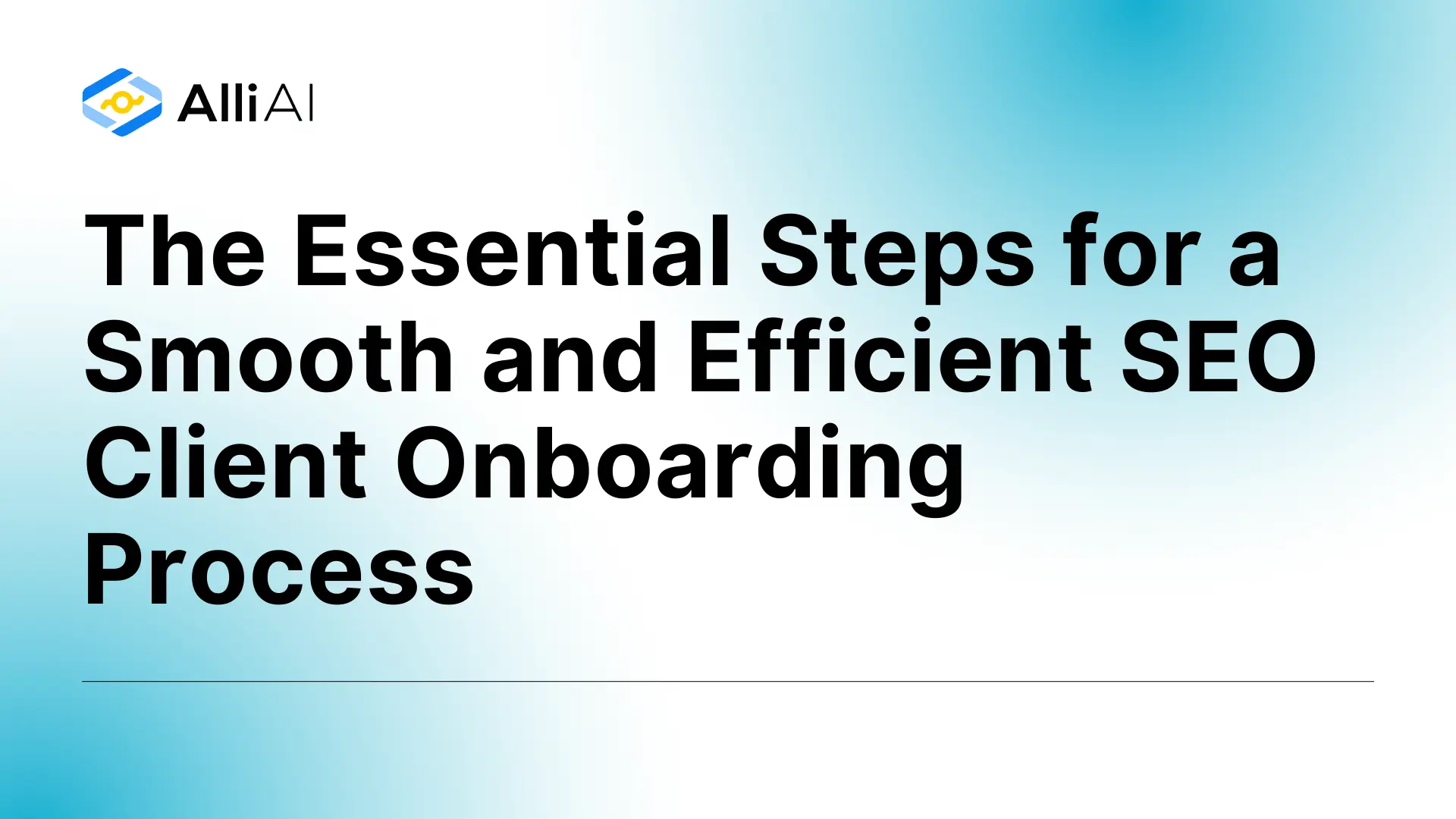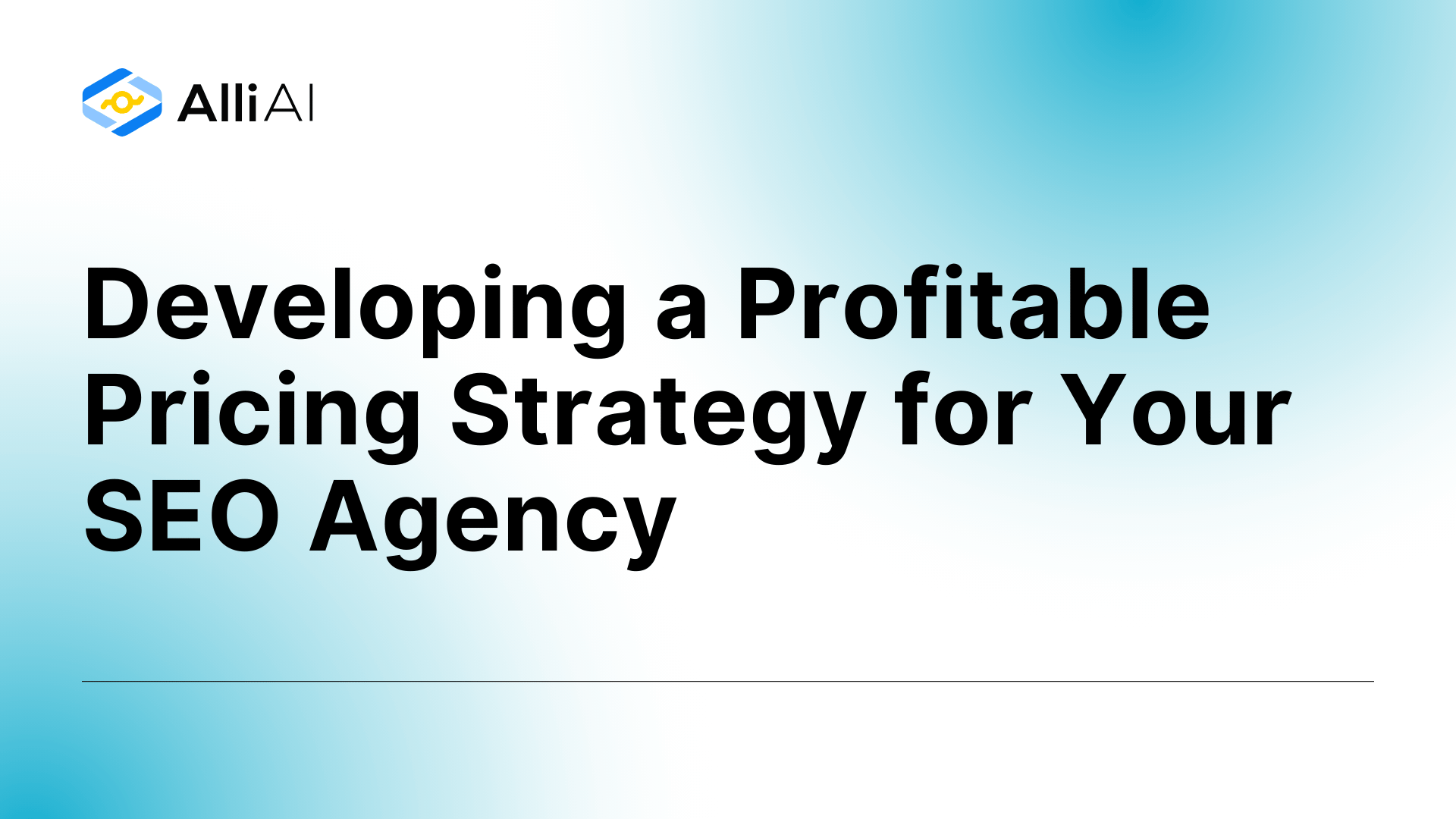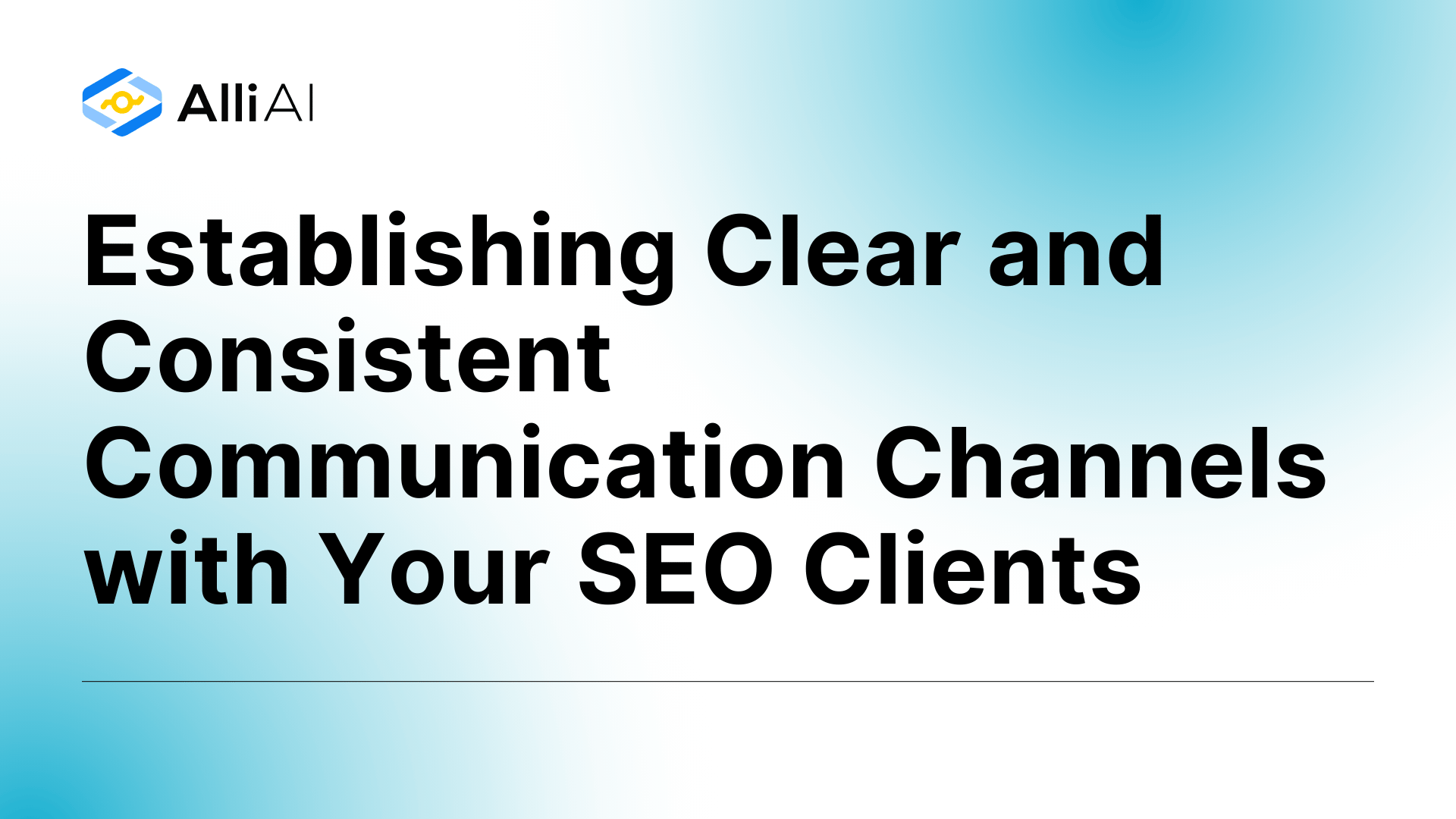Looking to convert more prospects into SEO clients? The “trick” is to structure your discovery calls strategically to uncover client needs while positioning yourself as a trusted advisor. This is the approach that has helped us transform our agency’s close rate from just 15% to over 40% in less than six months.
Many SEO professionals make the critical mistake of jumping straight into a discovery call without preparation, resulting in awkward pauses, redundant questions, and missed opportunities to establish credibility. But with the right framework, you can turn your discovery calls into powerful relationship-building tools that set the stage for successful long-term partnerships.
I’m going to show you exactly how to structure and execute effective SEO discovery calls that will help you qualify prospects, build trust, and ultimately win more business.
Step #1. Conduct Rigorous Pre-Call Preparation
Before you even think about picking up that phone or joining the Zoom call, you need to lay a solid foundation through preparation. This isn’t optional—it’s essential for success.
We’ve found that spending just 30 minutes on pre-call research can dramatically improve our discovery call quality and significantly increase our close rate. Why? Because it allows us to ask intelligent, targeted questions rather than generic ones that waste everyone’s time.
Here’s exactly what to research before your call:
- Company Information: Review their website thoroughly, especially the “About Us” section. For larger companies, check annual investor filings (like 10-Ks) which often reveal strategic priorities and revenue models.
- Industry Context: Familiarize yourself with the prospect’s industry, current trends, and common challenges. Nothing builds credibility faster than demonstrating you understand their specific market.
- Contact Research: Look up your prospect on LinkedIn to understand their role, responsibilities, and recent activity. This helps you tailor your approach to their specific pain points and motivations.
- Recent News: Check for recent company announcements like funding rounds, mergers, or product launches. Google News searches are perfect for this. These events often signal strategic shifts or budget availability.
- Initial SEO Analysis: Perform a quick technical SEO health check to identify obvious issues you can reference during the call. Using tools like Semrush or Ahrefs, look at:
- Technical SEO issues (slow site speed, broken links, indexing errors)
- On-page SEO elements (title tags, meta descriptions, header structure)
- Content quality and relevance
- Current keyword rankings for core terms
- Basic backlink profile
- Competitor Research: Identify their main competitors and analyze what they’re doing well in SEO that your prospect isn’t. Look for keyword gaps that represent opportunities.
Pro tip: Set up a structured template for your pre-call research so you can quickly document key findings. I’ve found this cuts my preparation time in half while ensuring I don’t miss critical details.
Once you’ve gathered this intelligence, create a focused agenda for the call and send it to the prospect beforehand. This simple act demonstrates organization and professionalism while setting clear expectations.
Table 1: Pre-Call Research Checklist
| Category | Checklist Item |
| Client Research | Review company website (About Us, Products/Services, Blog) |
| Research company size, industry, location, business model | |
| Check recent news (funding, M&A, partnerships, launches) via Google News | |
| Review prospect’s LinkedIn profile (role, history, activity, connections) | |
| Check CRM for past interactions/notes | |
| Understand industry trends and challenges | |
| Website Analysis | Check site speed (e.g., Google PageSpeed Insights) |
| Check mobile-friendliness | |
| Look for obvious technical issues (broken links, indexing via site: search) | |
| Review on-page elements (Title Tags, Meta Descriptions, Headers) on key pages | |
| Assess content quality, relevance, and structure (briefly) | |
| Quick backlink profile check (using tools like Ahrefs/Semrush free versions or overview) | |
| Competitor Research | Identify 3-5 key SEO competitors (via Google Search, client input, tools) |
| Perform keyword gap analysis (tools like Semrush/Ahrefs) | |
| Analyze competitor content types and topics | |
| Examine competitor backlink sources (briefly) | |
| Logistics & Planning | Define clear objectives for the call (e.g., qualify, understand needs, determine next step) |
| Create a structured agenda | |
| Send agenda to prospect in advance | |
| Prepare key open-ended questions based on research | |
| Test audio/video equipment and internet connection | |
| Set up a quiet, distraction-free environment | |
| Have note-taking tools ready | |
| Prepare brief support materials if needed (e.g., relevant quick insight) |
Step #2. Structure Your Call for Maximum Effectiveness
Having a clear structure for your discovery call prevents aimless conversation and ensures you cover all critical areas efficiently. For more on structuring calls, see these strategies for effective sales discovery calls. We’ve tested numerous frameworks and found this 6-phase approach consistently delivers the best results:
Phase 1: Introduction & Rapport Building (3-5 minutes)
Start with warm, conversational opening lines to establish a human connection beyond the business context. Use your pre-call research to find common ground if possible.
“Before we dive into the agenda, I noticed you previously worked at [Company X]—I’ve always been impressed with their approach to digital marketing. How long were you there?”
Phase 2: Agenda Review (Brief)
Quickly confirm the call’s purpose and structure:
“As I mentioned in my email, I’d like to learn more about your business goals and challenges, discuss your current SEO approach, share a bit about how we might help, and leave time for questions. Does that sound good?”
Phase 3: Needs Discovery (15-20 minutes)
This is the core of your call. Focus on understanding:
- Business goals (growth targets, key metrics)
- Current challenges and pain points
- Target audience and market positioning
- Past SEO experiences (what worked/didn’t)
The trick is to use open-ended questions starting with “What,” “How,” and “Why” rather than yes/no questions that limit insights.
Phase 4: Value Communication & Expectation Setting (10-15 minutes)
Based on their needs, briefly explain how your SEO approach could address their specific pain points. This is where you manage expectations about SEO timelines and results:
“Based on what you’ve shared about your competitive landscape, I should mention that SEO typically takes 3-6 months to show significant results in your industry. It’s a long-term investment rather than a quick fix.”
Phase 5: Qualification & Fit Assessment
Throughout the call, weave in questions to assess if they’re a viable client:
- Budget (“What budget have you allocated for SEO services?”)
- Authority (“Who else is involved in making this decision?”)
- Need (priority level of SEO compared to other initiatives)
- Timeline (“When are you looking to begin implementation?”)
Phase 6: Closing (5-10 minutes)
Summarize key points, confirm understanding, address final questions, and clearly define next steps with specific timelines.
Imagine that you’re wrapping up a call with an e-commerce prospect who’s struggling with declining organic traffic. Your closing might sound like:
“To recap, your main goals are to recover the 30% organic traffic loss you’ve experienced over the past six months and improve conversion rates from organic visitors. The next step would be for us to conduct a comprehensive technical audit to identify the root causes. I can have that proposal to you by this Friday—does that timeline work for you?”
The structure provides control while allowing flexibility to explore important insights that emerge during the conversation.
Step #3. Master Active Listening and Communication Techniques
The most successful SEO sales professionals I know spend more time listening than talking during discovery calls. This isn’t passive hearing—it’s active listening that demonstrates genuine interest and uncovers true needs.
We’ve found that aiming for the prospect to speak at least 60% of the time dramatically increases our close rate. Here’s how to master this essential skill:
Eliminate Distractions
Close email, silence notifications, and focus entirely on the conversation. Your full attention is the foundation of active listening.
Use the Paraphrasing Technique
After the prospect shares something important, restate it in your own words:
“So what I’m hearing is that your main concern isn’t just ranking higher, but specifically targeting keywords that attract qualified buyers rather than information seekers. Is that right?”
This confirms understanding and shows you’re truly engaged.
Ask Strategic Follow-Up Questions
When a prospect mentions a challenge, dig deeper with follow-up questions:
“You mentioned your organic traffic has dropped 30%. Have you identified any specific pages or sections of your site that were hit hardest?”
Leverage Strategic Silence
Your first thought might be to fill every pause, but allowing brief moments of silence after asking significant questions gives prospects time to formulate thoughtful responses. We’ve found that waiting just 3-5 seconds often leads to the most revealing insights.
Beyond listening, position yourself as a consultant rather than a salesperson by:
- Sharing relevant insights based on your pre-call research
- Focusing on understanding their situation before jumping to solutions
- Asking thought-provoking questions that demonstrate expertise
- Using the “Yes! And…” technique to validate their points while adding your perspective
When explaining SEO concepts, avoid excessive jargon and focus on business outcomes rather than technical details. Connect SEO activities to tangible results like increased leads, relevant traffic, and revenue impact.
Table 2: Active Listening Techniques Checklist
| Technique | Description | Example Phrases / Actions |
| Full Concentration | Eliminate distractions, focus solely on the speaker, maintain eye contact. | Close other tabs/apps, silence phone, look at the camera/speaker. |
| Avoid Interrupting | Let the speaker finish their thoughts completely before responding. | Wait for a natural pause before speaking. |
| Paraphrasing | Restate the speaker’s key points in your own words to confirm understanding. | “So, if I understand correctly, you’re saying…”, “It sounds like the main issue is…” |
| Summarizing | Briefly condense the main themes or points covered over a longer part of the conversation. | “Just to recap the key challenges you mentioned…”, “So, the main goals we discussed are…” |
| Asking Clarifying Qs | Seek more information or detail when something is unclear or requires deeper understanding. | “Could you elaborate on that?”, “What did you mean by…?”, “Can you give me an example?” |
| Asking Open-Ended Qs | Use questions starting with “What,” “How,” “Why,” or “Tell me about…” to encourage detailed responses. | “What are your biggest frustrations?”, “How does that impact your team?”, “Why is this a priority now?” |
| Using Non-Verbal Cues | Signal engagement through body language. | Nodding, leaning slightly forward, appropriate facial expressions (smiling when suitable). |
| Reading Non-Verbal Cues | Pay attention to the speaker’s body language, tone of voice, and expressions for deeper understanding. | Notice hesitation, enthusiasm, frustration conveyed through tone or posture. |
| Empathy / Validation | Acknowledge and validate the speaker’s feelings or experiences. | “That sounds really challenging.”, “I can understand why you’d feel that way.”, “It makes sense that…” |
| Using Silence | Intentionally pause after asking a question or after the speaker finishes to allow for reflection or additional thoughts. | Wait a few seconds before responding or asking the next question. |
| Taking Notes | Jot down key points, questions, and action items to aid memory and demonstrate attentiveness (without being distracting). | Use a notepad or digital tool discreetly. |
Step #4. Ask the Right Questions to Uncover True Needs
The questions you ask during an SEO discovery call are your primary tools for uncovering needs, qualifying the prospect, and gathering the information necessary to determine fit and formulate a potential strategy. Consider reviewing lists like these 24 Best Questions for an SEO Discovery Call for inspiration.
We’ve tested dozens of questioning approaches and found that quality trumps quantity. Six to nine well-crafted questions throughout the call will yield more valuable insights than 20+ superficial ones.
Here are the key areas to explore and sample questions for each:
Needs and Pain Points
- “What are your biggest frustrations with your current SEO results?”
- “What problem are you ultimately trying to solve through improved search visibility?” (See these questions to discover buyer’s pain points for ideas).
- “How does your current lack of organic visibility impact your business operations?”
Goals and Objectives
- “What are your top three business goals for the next 6-12 months?”
- “What does success look like for you with this SEO initiative?”
- “How does improving organic search fit into your overall marketing strategy?”
KPIs and Success Metrics
- “How will you measure the success of this SEO engagement?”
- “What metrics are most important to your leadership team?”
- “How are you currently tracking campaign results?” (Effective keyword rank tracking is crucial here).
Budget and Resources
- “What is your approximate monthly budget allocated for SEO services?”
- “Do you have internal resources like a developer or content writer available to support implementation?”
- “How have you historically invested in digital marketing?”
Timeline and Urgency
- “What’s your timeline for achieving these goals?”
- “Why is solving this problem a priority today versus six months ago?”
- “How quickly are you looking to see results?”
Past SEO Experience
- “What has been your experience with SEO agencies or efforts so far?”
- “What have you tried in the past that worked well? What didn’t?”
- “To your knowledge, has your website ever been penalized by Google?”
The SPIN Selling framework (Situation, Problem, Implication, Need-Payoff) can be particularly effective for structuring your questioning:
Situation Questions: “Tell me about your current website platform.”
Problem Questions: “What are the biggest obstacles you face in generating qualified organic leads?”
Implication Questions: “How does the lack of visibility for target keywords impact your sales pipeline?”
Need-Payoff Questions: “How would achieving a 25% increase in organic traffic benefit your overall business objectives?”
This framework helps guide the prospect to recognize the need and potential benefits themselves, making your eventual solution feel like a logical conclusion rather than a hard sell.
Table 3: Client Fit Assessment / Red Flag Checklist
| Assessment Criterion | Green Flags / Good Signs | Red Flags / Warning Signs |
| Realistic Expectations | Understands SEO is long-term, results vary, no guarantees. Focuses on business KPIs. | Demands guaranteed #1 rankings, instant results, unrealistic timelines. Focuses solely on vanity metrics. |
| Budget Alignment | Willing to discuss budget openly. Budget aligns with goals and scope. Understands SEO is an investment. | Unwilling to discuss budget, budget drastically low for goals, excessive haggling, refusal of standard terms (e.g., upfront payment). |
| Respect & Collaboration | Respects agency expertise and process. Engages collaboratively. Communicates professionally. Values agency’s time. | Disrespectful behavior, constant interruptions, micromanagement attempts, dismissive of process/expertise. Unprofessional communication. |
| Transparency & Communication | Openly shares information, goals, challenges. Responsive communication. Clear about decision process. | Vague answers, evasiveness, reluctance to share info/access. History of poor communication or “ghosting” past agencies. |
| Resource Availability | Has necessary internal resources (dev, content) or budget to outsource implementation needs. | Lacks critical resources for implementation and expects agency to cover without appropriate budget/scope. |
| Values Alignment | Business ethics and approach align with agency values. Seeks mutually beneficial partnership. | Fundamental mismatch in business ethics or vision. Focuses solely on own benefit (“win-lose”). |
| Past Agency History | Provides reasonable explanation for past agency changes (if any). Understands agency role. | History of frequently changing agencies (“agency hopping”), excessively blames past agencies for all issues. |
| Formal Agreements | Willing to sign standard contracts and adhere to documentation processes. | Aversion to signing contracts or agreeing to documented terms/scope. |
| Need & Priority | Clearly articulated need that SEO can address. Problem is a stated priority with some urgency. | Need is vague or ill-defined. Lack of clear priority or urgency for solving the problem. |
| Decision Authority | Contact person has decision-making power or clear influence, and process is understood. | Contact lacks authority, decision process is unclear/convoluted, key stakeholders inaccessible. |
Step #5. Qualify Properly and Follow Up Effectively
Not every prospect is the right fit for your SEO services, and that’s perfectly okay. In fact, identifying poor-fit clients early can save you significant time, resources, and frustration down the road.
We’ve learned (sometimes the hard way) to carefully assess prospects against these key criteria:
Need Alignment
Is their core challenge something SEO can realistically address? If they’re primarily seeking instant results or have fundamentally flawed business models, SEO might not be the right solution.
Budget Alignment
Is their budget realistic given their goals and competitive landscape? We’ve found that clients with unrealistic budget expectations (“I want to outrank Amazon with $500/month”) almost always become problematic.
Expectation Alignment
Do they understand that SEO is a long-term investment without guaranteed rankings? Red flags include insisting on guaranteed #1 rankings or demanding immediate results.
Collaboration Potential
Do they seem willing to provide necessary information and access to platforms? Prospects who are secretive or unwilling to share basic information during discovery often become difficult clients.
Values Alignment
Do their business practices and overall approach resonate with your values? This often becomes apparent through how they treat you during the discovery process.
Be vigilant for these specific red flags that signal potentially problematic clients:
- Complete unwillingness to discuss budget
- Excessive haggling over standard pricing
- Unprofessional behavior during the call
- Vague or evasive answers to key questions
- History of “agency hopping” with excessive blame on previous providers
It’s perfectly acceptable to politely disengage from prospects who exhibit multiple red flags. Your time is valuable, and focusing on quality partnerships rather than quantity will yield better results long-term.
Once you’ve concluded the call, follow up promptly with a well-crafted email that includes:
- A personalized greeting and expression of gratitude
- A concise summary of key takeaways
- Links to requested information or resources
- Clear restatement of next steps, responsibilities, and timelines
- A professional closing with your contact information
Send this follow-up within 24 hours while the conversation is still fresh. This bridges the gap between verbal agreements and subsequent actions, reinforcing your professionalism and maintaining momentum.
Table 4: Follow-Up Email Template Elements
| Email Section | Purpose | Key Content / Example Phrases |
| Subject Line | Clear identification & reference | “Following Up: SEO Discovery Call with [Company]”<br>”Recap & Next Steps: [Company] Discovery Call” |
| Greeting & Gratitude | Personal connection, show respect for time | “Hi [Prospect Name],”<br>”Thank you again for taking the time to speak with me today/yesterday. I enjoyed learning more about [Company].” |
| Recap Key Takeaways | Confirm understanding, reinforce key points | “It was helpful to discuss your goals around [Goal 1] and the challenges you’re facing with [Pain Point 1].” <br> “Key takeaways from our conversation included: <br> – Need for… <br> – Goal of… <br> – Challenge with…” (Use bullets) |
| Highlight Value / Shared Interest (Optional) | Reinforce alignment and potential benefit | “Based on our discussion, it seems our approach to could directly address your need for.” <br>”I was particularly interested in our shared focus on.” |
| Address Action Items / Provide Resources | Fulfill promises made during the call | “As promised, here is the link to the case study we discussed: [Link]” <br>”I’ve attached the overview of our process.” |
| Reiterate Next Steps | Clarify agreed actions, timelines, responsibilities | “To confirm our next steps: <br> 1. I will send the proposal by [Date]. <br> 2. We have scheduled our follow-up demo for [Date] at.” <br>”Look forward to our call scheduled for.” |
| Call to Action (Soft/Relevant) | Prompt necessary action from prospect | “Please let me know if the proposed time for our next call works for you.” <br>”Feel free to share this with as discussed.” |
| Professional Closing | Maintain professionalism, provide contact info | “Best regards,” / “Sincerely,”<br>[Your Name]<br><br>[Your Company]<br>[Contact Info / Website Link] |
Putting It All Together: The Power of a Structured Approach
Mastering the SEO discovery call isn’t about clever sales tactics—it’s about creating a strategic framework that allows you to truly understand your prospect’s needs while positioning yourself as a trusted advisor rather than just another vendor.
By implementing these five steps consistently, you’ll:
- Establish credibility through thorough preparation
- Create a comfortable, productive environment with clear structure
- Build trust through active listening and consultative positioning
- Uncover true needs with strategic questioning
- Qualify effectively to focus on ideal-fit clients
Remember that the goal of a discovery call isn’t necessarily to close the deal on the spot. It’s to determine if there’s mutual fit, understand the prospect’s unique situation, and establish a foundation for a potentially valuable long-term partnership.
The most successful SEO professionals approach discovery calls with genuine curiosity and a desire to solve problems, not just sell services. When you truly focus on understanding and helping, the sales process becomes more natural and effective.
Apply these strategies consistently, and you’ll see a significant improvement in both the quality of your client relationships and your overall close rate. The difference between average and exceptional SEO providers, especially those using an agency SEO tool, often comes down to mastering this critical first step in the client journey.
What discovery call challenges are you currently facing? I’d love to hear about your experiences in the comments below.






